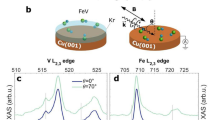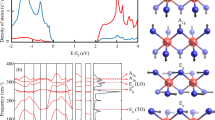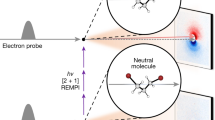Abstract
MATRIX isolation has been widely used to trap reactive species in the cavities of an inert host for subsequent spectroscopic observation1. Occasionally, spectral features appeared which could not be ascribed to the single trapped species and had to be attributed to an aggregate. These bands were generally regarded as parasitic and their origin was not pursued. We have discovered that metal dimers can be readily formed in large quantities in matrix conditions and that the bands associated with these entities can be identified readily using a novel technique which makes use of the fact that the metal atoms being deposited are capable of diffusion either on the matrix surface or within a narrow region (the reaction zone) near the surface before its kinetic energy is dissipated sufficiently to immobilise it.
This is a preview of subscription content, access via your institution
Access options
Subscribe to this journal
Receive 51 print issues and online access
$199.00 per year
only $3.90 per issue
Buy this article
- Purchase on Springer Link
- Instant access to full article PDF
Prices may be subject to local taxes which are calculated during checkout
Similar content being viewed by others
References
Whittle, E., Dows, D. A., and Pimentel, G. C. J. Chem. Phys., 22, 1943 (1954).
Kündig, E. P., Moskovits, M., and Ozin, G. A., J. molec Struct., 14, 137 (1972).
Moskovits, M., and Ozin, G. A., Appl. Spect 26, 481 (1972).
Mann, D. M., and Broida, H. P., J. Chem. Phys., 55, 84 (1971).
Moore, C. E., Atomic Energy Levels, National Bureau of Standards Circular 467.
Author information
Authors and Affiliations
Rights and permissions
About this article
Cite this article
KÜNDIG, E., MOSKOVITS, M. & OZIN, G. Matrix synthesis and characterisation of dichromium. Nature 254, 503–504 (1975). https://doi.org/10.1038/254503a0
Received:
Published:
Issue Date:
DOI: https://doi.org/10.1038/254503a0
This article is cited by
-
A computational investigation of boron-doped chromium and chromium clusters by density functional theory
Science China Physics, Mechanics and Astronomy (2010)
-
Ultrashort metal–metal distances and extreme bond orders
Nature Chemistry (2009)
-
Laser vaporization: A versatile method for studying metal clusters
Proceedings / Indian Academy of Sciences (1991)
Comments
By submitting a comment you agree to abide by our Terms and Community Guidelines. If you find something abusive or that does not comply with our terms or guidelines please flag it as inappropriate.



